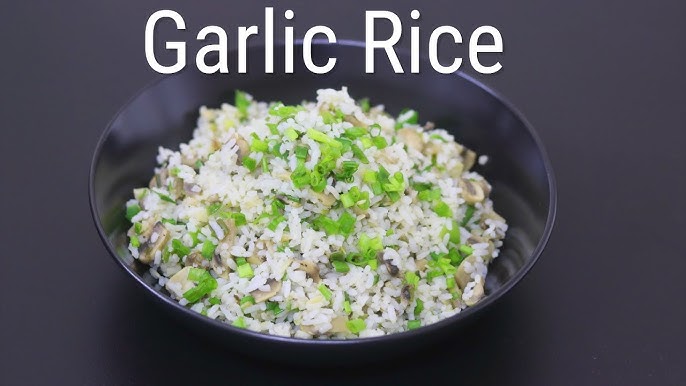Garlic Rice Recipe: Garlic rice is one of those simple yet incredibly flavorful dishes that never goes out of style. At its core, it’s just rice flavored with garlic, but anyone who has ever tasted it knows that it’s far more than that. The aroma of sautéed garlic alone is enough to make mouths water, and when combined with fluffy rice, it becomes a comfort food that people across the world enjoy.
This dish isn’t just popular in one region; it shows up in kitchens globally. In the Philippines, garlic rice, known as sinangag, is often enjoyed for breakfast alongside fried eggs and cured meats. In India, garlic rice can be spicy and aromatic, sometimes flavored with curry leaves and chili. Meanwhile, in Western kitchens, garlic rice is a quick side dish to elevate grilled meats, seafood, or even vegetarian meals. Its versatility makes it a household favorite.
What makes garlic rice stand out is its ability to be both humble and sophisticated. On a busy weekday, it can be whipped up with leftover rice and a few cloves of garlic. On a special occasion, it can be dressed up with herbs, butter, or even a touch of soy sauce for added depth. The best part is that it requires very little effort for maximum payoff.
If you’ve ever struggled with what to serve on the side of your main dish, garlic rice is a go-to option. It pairs beautifully with stir-fries, curries, grilled proteins, and even simple vegetable dishes. Think of it as the blank canvas that absorbs flavors while still standing strong with its own garlicky punch.
In this guide, we’ll walk you through everything—from gathering the right ingredients to mastering the perfect balance of garlic flavor. Whether you’re a seasoned cook or a beginner in the kitchen, you’ll find that garlic rice is one of the easiest and most rewarding dishes you can prepare.
Ingredients You’ll Need
The beauty of garlic rice lies in its simplicity, and the ingredients are likely already sitting in your kitchen. At its most basic, you’ll need just rice, garlic, oil, and salt. But if you’re looking to enhance it, there are plenty of optional add-ons that can take it to the next level. Let’s break it down:
Essential Ingredients:
- Rice: You can use freshly cooked rice or leftover rice. Leftover rice tends to work better since it’s less sticky and easier to fry. Jasmine or basmati rice is ideal because of their fragrance and texture.
- Garlic: The star of the dish. Use fresh cloves, not garlic powder, to get that authentic aroma and flavor.
- Cooking Oil or Butter: Neutral oils like vegetable or canola oil work well, but butter or olive oil can give a richer taste.
- Salt: For seasoning and balancing the flavors.
Optional Add-ons for Extra Flavor:
- Soy Sauce or Oyster Sauce: For a savory, umami boost.
- Green Onions or Chives: Adds freshness and color.
- Chili Flakes or Fresh Chili: For those who love a little heat.
- Eggs: You can scramble them into the rice or serve with a fried egg on top.
- Sesame Oil: Just a few drops add a nutty aroma.
- Fresh Herbs: Parsley, cilantro, or basil for a twist.
Tips for Choosing Ingredients:
- Always choose fresh, firm garlic cloves. Avoid ones that are sprouting or soft.
- If using leftover rice, refrigerate it overnight. Cold rice fries better and doesn’t clump together.
- Balance your choice of fat—oil makes it lighter, butter makes it indulgent.
Having these ingredients ready ensures a smooth cooking process. Even if you stick to the basics, you’ll end up with a dish that’s aromatic, satisfying, and surprisingly versatile.
Preparing Your Ingredients
Before you fire up the stove, taking a few minutes to properly prepare your ingredients can make a big difference in the final result. Garlic rice is straightforward, but precision in preparation is what elevates it from “good” to “amazing.”
Prepping the Garlic: Start with fresh garlic cloves. Peel them and then decide how you want to cut them. For a more intense garlic flavor, mince it finely. If you prefer a milder taste and crunch, slice it thinly. Some cooks even like to crush the garlic slightly before chopping to release more of its oils. Just remember: the smaller the cut, the quicker it cooks—so be careful not to burn it.
Choosing the Rice: This is a critical step. If you’re making rice fresh, cook it with slightly less water than usual so it’s not too soft. Fluffy grains separate better when stir-frying. Leftover rice from the fridge is even better because it’s drier and less sticky, making it perfect for garlic rice. Jasmine rice gives a slightly floral aroma, while basmati offers a light, nutty flavor.
Prepping Seasonings and Garnishes: Have your salt, soy sauce, or any other seasonings ready before you start cooking. Garlic browns quickly, so you won’t have time to fumble for ingredients once it hits the pan. If you’re adding green onions, herbs, or chili, chop them ahead of time. A squeeze of lemon at the end can also add a bright touch.
Organize Your Workspace: Lay out everything you’ll need—garlic, rice, oil, seasonings, garnishes. This way, once you start cooking, it’s just a matter of tossing things in at the right time. Think of it as setting up your own mini “cooking show” station.
By prepping properly, you not only save time but also ensure that your garlic rice cooks evenly and tastes perfectly balanced.
Step-by-Step Guide to Making Garlic Rice
Now comes the exciting part—actually cooking the garlic rice. While the process is simple, paying attention to details ensures you end up with fluffy, flavorful rice rather than clumpy or burnt grains. Here’s the breakdown:
Step 1: Cooking the Rice
If you’re using fresh rice, rinse it thoroughly to remove excess starch. Cook with slightly less water than usual. Once done, fluff it with a fork and let it cool slightly so it doesn’t clump. If using leftover rice, break it apart with your fingers before adding to the pan.
Step 2: Sautéing the Garlic
Heat oil or butter in a large skillet or wok over medium heat. Add the garlic and cook until golden brown and fragrant. Be careful—garlic burns easily, and burnt garlic can ruin the entire dish with its bitter taste. Stir continuously for even cooking.
Step 3: Combining Rice with Garlic
Once the garlic is golden, add the rice to the pan. Stir-fry it, making sure each grain gets coated with that aromatic garlic oil. Use a spatula or wooden spoon to press and toss the rice so it doesn’t clump.
Step 4: Seasoning for Flavor Balance
Add salt to taste. If you’re using soy sauce or oyster sauce, drizzle a small amount and stir well. Be cautious not to add too much—garlic rice is meant to highlight the garlic, not overwhelm it.
Step 5: Adding Garnishes and Serving
Toss in chopped green onions, chili flakes, or herbs if you’d like. Finally, transfer the rice to a serving bowl and top it with a fried egg for a complete meal.
Cooking garlic rice takes only about 15 minutes once everything is prepped, making it an ideal dish for busy days. The aroma will fill your kitchen, and the taste will leave everyone asking for seconds.
Expert Tips for Perfect Garlic Rice
Making garlic rice might sound easy, but there are little secrets that separate a decent dish from a restaurant-quality one. Here are some expert tips to ensure your garlic rice always turns out perfect:
1. Don’t Burn the Garlic
This is the number one rule. Garlic goes from golden brown to burnt in seconds. Always cook it over medium heat and stir continuously. If it turns too dark, start over—burnt garlic will give your rice a bitter taste.
2. Use Cold Rice if Possible
Freshly cooked rice can be too moist, leading to clumps. Cold, day-old rice is ideal because it’s drier and absorbs the garlic oil better. If you only have fresh rice, spread it out on a tray for a few minutes to let it cool before frying.
3. Balance the Oil
The garlic needs enough oil to fry evenly, but too much oil will make the rice greasy. A good rule of thumb is about 2 tablespoons of oil for 3 cups of rice.
4. Choose the Right Pan
A wide skillet or wok works best. It gives you enough space to toss the rice without it spilling over. A non-stick pan also makes the process easier.
5. Experiment with Add-Ons
Once you master the basic version, feel free to experiment. Add scrambled eggs, vegetables, or even small bits of cooked chicken or shrimp for a heartier version.
By following these tips, you’ll get garlic rice that’s light, fluffy, and bursting with flavor every time.
Serving Suggestions for Garlic Rice
One of the best things about garlic rice is how versatile it is when it comes to pairing with other dishes. It’s not just a simple side—it can transform into the star of the meal depending on what you serve it with. Let’s explore different ways you can enjoy it:
1. With Breakfast Dishes
In Filipino cuisine, garlic rice is often served with fried eggs (itlog) and cured meats like longganisa (Filipino sausage) or tocino (sweet cured pork). This trio, known as “silog meals,” is a hearty way to start the day. A runny yolk from a sunny-side-up egg mixing with garlicky rice is pure breakfast perfection.
2. With Grilled or Fried Meats
Garlic rice pairs beautifully with grilled chicken, pork chops, or steak. The garlicky aroma enhances the smoky flavor of the meat, creating a comforting and filling combination. Fried dishes like crispy chicken wings or fried fish also balance perfectly with garlic rice, cutting through the oiliness with its savory taste.
3. With Asian Main Courses
Pair garlic rice with teriyaki chicken, sweet-and-sour pork, or even spicy curries. Its mild yet flavorful base complements strong sauces without overpowering them. Thai dishes like basil chicken or green curry taste even better with a scoop of garlic rice.
4. As a Vegetarian Option
If you’re vegetarian, garlic rice still has plenty to offer. Pair it with sautéed vegetables, stir-fried tofu, or grilled mushrooms. Add sesame oil and roasted peanuts on top, and you’ll have a wholesome, plant-based meal.
5. As a Standalone Dish
Sometimes, garlic rice doesn’t need any accompaniment at all. Add a fried egg on top, sprinkle with green onions, and drizzle a bit of soy sauce—you’ve got a quick, comforting bowl of food that satisfies anytime.
So whether you’re serving garlic rice for breakfast, lunch, or dinner, it fits in seamlessly with countless cuisines. Think of it as a versatile sidekick that can also be the main attraction when needed.
Nutritional Value of Garlic Rice
Garlic rice isn’t just tasty; it also comes with some surprising health benefits. While it’s not the lightest dish in terms of calories, its ingredients do offer nutrition that makes it more than just comfort food. Let’s break down its nutritional value:
Calories and Carbohydrates
Rice, being the base, provides a good source of carbohydrates—your body’s primary fuel. A one-cup serving of garlic rice typically has around 200–250 calories, depending on the oil or butter used. This makes it a good source of quick energy, especially when paired with protein-rich foods.
The Power of Garlic
Garlic isn’t just about flavor; it’s packed with health benefits. It contains compounds like allicin, which has antibacterial and antiviral properties. Garlic is also known to boost immunity, reduce blood pressure, and improve heart health. Eating garlic regularly, even in small amounts, can be beneficial.
Fats and Oils
The oil or butter you use contributes to the fat content. If you’re aiming for a healthier version, choose olive oil or avocado oil, both of which provide healthy fats that support heart health. Using too much butter can make the dish heavier, so balance is key.
Micronutrients
Depending on what extras you add, garlic rice can also provide vitamins and minerals. For example, green onions add vitamin K and C, eggs add protein and vitamin D, and sesame oil contributes antioxidants.
Is Garlic Rice Healthy?
On its own, garlic rice is a moderate dish—it’s not unhealthy, but it’s also not “diet food.” The key is portion control and balance. Serve it with protein and vegetables for a complete, nutrient-dense meal.
In short, garlic rice is more than just a tasty carb dish; it brings together flavor and nutrition in a way that makes it both enjoyable and beneficial.
Different Variations of Garlic Rice
One of the reasons garlic rice is so beloved is because it can be customized endlessly. Different regions and cultures put their own twist on it, making it a truly global dish. Here are some popular variations you might want to try:
1. Filipino Sinangag
This version uses leftover rice and lots of fried garlic bits. It’s usually kept simple, seasoned only with salt, and served as part of a traditional Filipino breakfast alongside fried meats and eggs.
2. Indian Garlic Rice
In India, garlic rice often gets a spiced-up twist. Curry leaves, dried red chilies, and mustard seeds are sautéed along with garlic, giving the dish a bold, aromatic flavor. It pairs perfectly with lentils or vegetable curries.
3. Japanese Garlic Fried Rice
Japanese versions sometimes include soy sauce, butter, and even small chunks of steak. It’s often served in teppanyaki-style cooking, where garlic rice is stir-fried on a hot plate with sizzling meats.
4. Spicy Garlic Rice
For spice lovers, adding chili flakes, bird’s eye chilies, or hot sauce creates a fiery version of garlic rice. This pairs beautifully with grilled seafood or barbecued dishes.
5. Herb-Infused Garlic Rice
Fresh herbs like parsley, cilantro, or basil can be added for a refreshing twist. A drizzle of lemon juice gives it a zesty finish that pairs well with roasted chicken or fish.
6. Vegan Garlic Rice
Skip the butter and use plant-based oils. Add vegetables like peas, carrots, and mushrooms for a hearty vegan version that’s still flavorful and satisfying.
The best part? You don’t have to stick to just one variation. Garlic rice is a flexible dish that allows you to experiment based on what you have in your kitchen. Each version highlights garlic in a unique way, proving just how versatile this simple recipe can be.
Common Mistakes to Avoid
Even though garlic rice seems simple, there are a few mistakes that can make or break the dish. Knowing what to avoid can save you from disappointment and help you nail the recipe every single time.
1. Burning the Garlic
The most common mistake is overcooking the garlic. Once it turns dark brown, it becomes bitter and unpleasant. Always cook garlic on medium heat and remove it from the pan the moment it’s golden.
2. Using Wet or Sticky Rice
If your rice is too wet, it will clump together when you stir-fry it. Always use day-old rice or cook fresh rice with slightly less water. Spreading freshly cooked rice on a tray to cool before using is another great trick.
3. Adding Too Much Oil
Yes, garlic needs oil to fry, but drowning the rice in oil will make it greasy. Stick to 2–3 tablespoons for 3 cups of rice.
4. Over-seasoning with Soy Sauce
While soy sauce adds umami, too much can overpower the garlic flavor. Remember—the star of this dish is garlic, not soy.
5. Not Prepping Ingredients Beforehand
Garlic cooks fast, so if you’re scrambling to chop onions or find your seasonings while it’s on the stove, you risk burning it. Always prep everything before you start.
6. Using the Wrong Pan
A small or crowded pan makes it hard to stir-fry the rice properly. Always use a wide skillet or wok to allow enough space for tossing.
Avoiding these mistakes ensures that your garlic rice turns out fragrant, fluffy, and perfectly seasoned every time.
Storage and Reheating Instructions
Garlic rice is best enjoyed fresh off the stove, but that doesn’t mean leftovers should go to waste. Proper storage and reheating techniques can help you enjoy it later without losing its texture or flavor.
Storing Garlic Rice:
- Room Temperature: Don’t leave garlic rice sitting out for more than 2 hours. Rice can develop harmful bacteria when kept at room temperature too long.
- Refrigerator: Place cooled rice in an airtight container and refrigerate within 1 hour of cooking. It will stay good for up to 3–4 days.
- Freezer: Garlic rice also freezes well. Store it in freezer-safe bags or containers for up to 1 month. Just flatten the bags for easier stacking and quicker thawing.
Reheating Garlic Rice:
- Microwave Method: Sprinkle a little water over the rice, cover it with a damp paper towel, and microwave in short bursts until heated through. This prevents it from drying out.
- Stovetop Method: Heat a pan with a small amount of oil or butter, then add the rice and stir-fry until hot. This method revives the flavor and makes the rice taste freshly cooked.
- Steaming Method: Place the rice in a heatproof bowl and steam for a few minutes. This works especially well if the rice has dried out in the fridge.
Pro Tip: Always reheat only the portion you plan to eat. Repeatedly reheating rice increases the risk of bacterial growth and can affect its texture.
With proper storage and reheating, garlic rice remains delicious even days after it was first prepared.
Garlic Rice for Special Occasions
While garlic rice is often considered an everyday dish, it can also shine on special occasions. With a few tweaks, you can elevate it from simple comfort food to a centerpiece worthy of family gatherings or dinner parties.
Festive Add-Ins:
- Add saffron or turmeric for a golden color and a subtle earthy flavor.
- Toss in peas, corn, or bell peppers for a vibrant look.
- Mix in nuts like cashews or almonds for a crunchy texture.
Pairing with Holiday Meals:
- Garlic rice makes a great side dish for roasted turkey, ham, or lamb.
- For seafood feasts, it pairs beautifully with grilled shrimp, baked salmon, or lobster.
- In Asian-inspired gatherings, it can be served alongside dumplings, stir-fried noodles, or sweet-sour chicken.
Plating Ideas:
Instead of simply piling it onto a plate, try serving garlic rice in a decorative bowl, garnishing with fresh herbs, or molding it into shapes using small bowls or cups for a more elegant presentation.
When dressed up, garlic rice can easily compete with fancier dishes, showing that simplicity doesn’t mean plainness.
Pairing Garlic Rice with Other Dishes
Garlic rice is versatile enough to work with different types of cuisine, making it a perfect base for experimenting with flavors. Here are some tried-and-tested pairings:
Asian Pairings:
- Sweet and sour chicken
- Beef teriyaki
- Thai basil stir-fry
- Spicy Korean fried chicken
Western Pairings:
- Grilled steak with garlic butter
- Roasted chicken with herbs
- Pan-seared salmon
- Garlic shrimp or scampi
Vegetarian Pairings:
- Sautéed mushrooms with soy sauce
- Grilled zucchini and eggplant
- Stir-fried tofu
- Roasted chickpeas with spices
Fusion Ideas:
Want to get creative? Try using garlic rice as a stuffing for bell peppers or wrap it in tortillas for a unique garlic rice burrito. You can even use it as a base for rice bowls topped with avocado, beans, and salsa.
This ability to pair well with almost any dish is what makes garlic rice a staple in so many kitchens.
Why Garlic Rice is Loved Worldwide
Garlic rice has earned a place in kitchens across continents for several reasons—it’s easy, budget-friendly, delicious, and deeply comforting. But let’s dive into why people from different cultures embrace it:
Universal Ingredient – Garlic:
Garlic is one of the most widely used ingredients in the world. From Italian pasta sauces to Indian curries, garlic plays a key role in global cuisines. Garlic rice, therefore, becomes a familiar comfort food that resonates with many people.
Simplicity with Flavor:
It proves that simple ingredients can deliver bold flavors. Even if you have just garlic, rice, and oil, you can whip up something satisfying.
Adaptability:
Every culture puts its own twist on garlic rice. Whether it’s the spiced Indian version, the simple Filipino sinangag, or the buttery Japanese garlic fried rice, each variation shows how adaptable the dish is.
Nostalgia Factor:
For many, garlic rice isn’t just food—it’s a memory. Families often pass down recipes, making it a comfort dish tied to childhood and home-cooked meals.
Affordability:
Rice and garlic are inexpensive staples, making this dish accessible to households everywhere. It’s proof that good food doesn’t have to be expensive.
In short, garlic rice embodies the perfect balance of comfort, flavor, and accessibility, which is why it continues to be loved globally.
FAQs about Garlic Rice Recipe
1. Can I make garlic rice without oil?
Yes, you can use butter or even a splash of broth instead of oil. However, oil helps achieve that classic fried flavor.
2. What’s the best rice for garlic rice?
Day-old jasmine or basmati rice works best. Fresh rice can be too sticky, but if you use it, spread it out to cool first.
3. How do I make garlic rice less greasy?
Use just enough oil to fry the garlic and coat the rice lightly. About 2 tablespoons for 3 cups of rice is ideal.
4. Can I freeze garlic rice?
Yes, garlic rice freezes well for up to 1 month. Store in airtight bags and reheat in a pan or microwave with a splash of water.
5. How do I make garlic rice more flavorful?
Add soy sauce, chili flakes, sesame oil, or fresh herbs like parsley and cilantro. You can also top it with a fried egg or grilled meat.
Conclusion
Whether you’re making it for a quick breakfast, pairing it with grilled meats, or dressing it up for a festive gathering, garlic rice never disappoints. Its global variations, nutritional benefits, and adaptability make it a dish everyone should know how to cook.
So the next time you’re wondering what to make with leftover rice or need a flavorful side dish, remember this recipe. Garlic rice is the kind of dish that fits every mood, every table, and every appetite.



